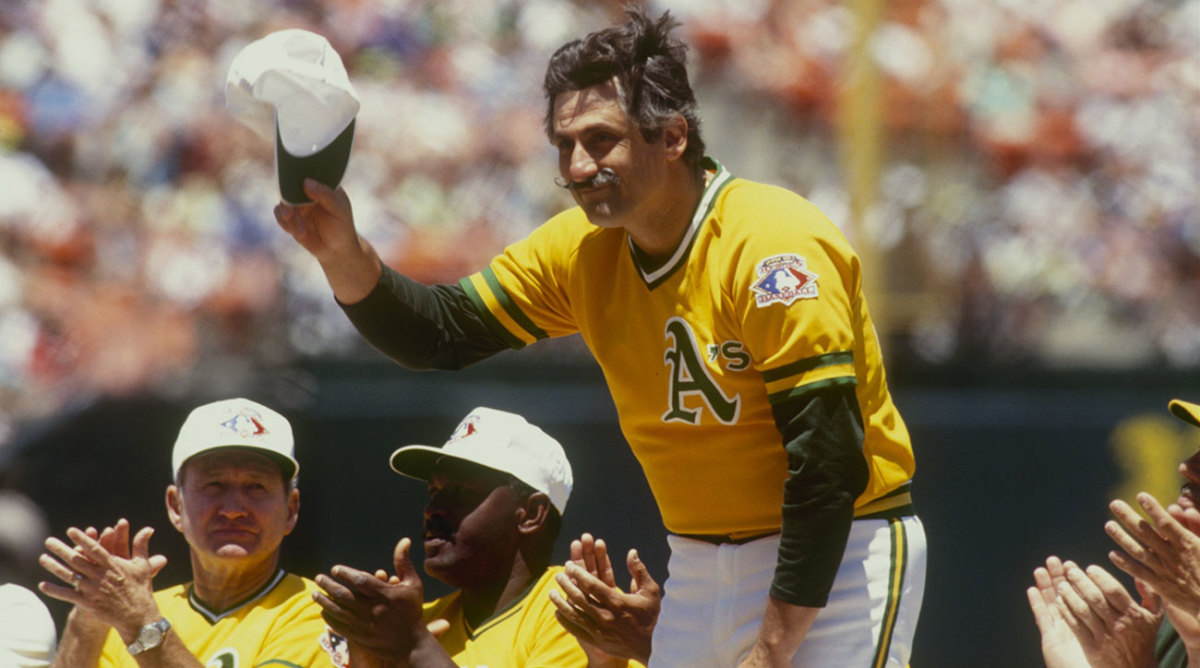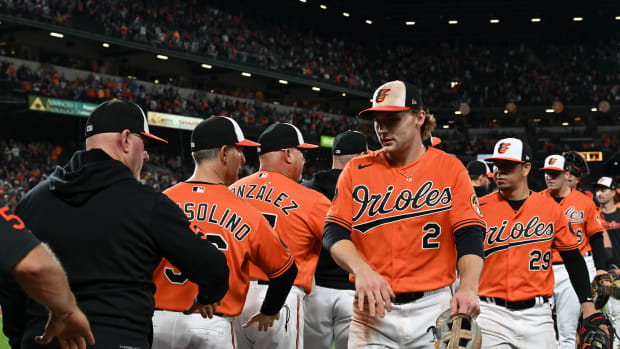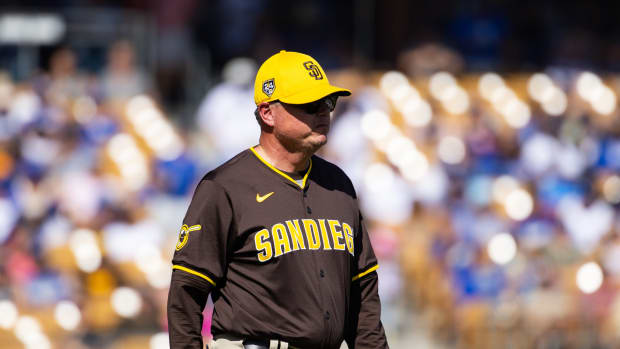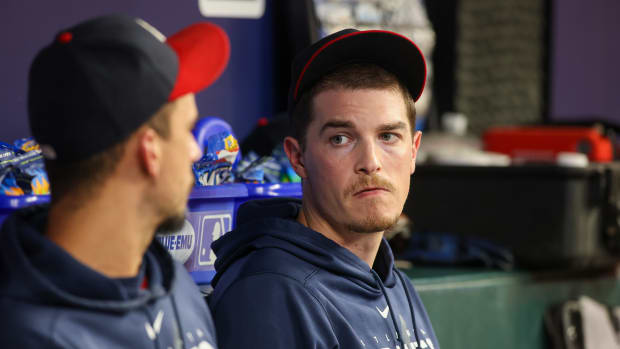Remembering the Short-Lived, Ill-Fated Senior Professional Baseball Association

At a mid-June memorabilia show in San Bernardino, Calif., Hall of Fame pitcher Rollie Fingers is signing dozens and dozens of baseball cards. Almost all of the cards he signs are from his storied time with the Oakland Athletics or Milwaukee Brewers. A few, however, aren’t from his time in the big leagues.
Fingers’s trademark moustache is a bit thinner on this specific card. A palm tree logo is fixated on his red cap. He looks older in his portrait, having retired from MLB years before.
It’s a relic from his lone year with the West Palm Beach Tropics–one of the eight original teams in the short-lived Senior Professional Baseball Association. Fingers is among a large group of former big leaguers who took advantage of an upstart league full of baseball’s elders. Thirty years ago, when a senior professional baseball league was born, the Hall of Fame closer found himself competing against heralded peers such as Fergie Jenkins, Luis Tiant, Ron Washington, Bobby Bonds and Vida Blue.
Some players were looking to make a quick buck. Others were fighting for another shot in the majors. Many players, however, were just trying to rekindle some of their prior magic. “You feel like you living again,” Tiant says of his time in the SPBA. “I was born again when I was pitching.”
In January 1989, real estate developer Jim Morley flew to Australia in search of money-making ideas, according to David Whitford in his book Extra Innings: A Season in the Senior League. Whitford writes that Morley’s girlfriend suggested opening a restaurant, a bead store or a balloon-delivery service, but Morley saw those as “goofy ideas.” Instead, he turned to baseball.
Morley scanned the sports page in Australia, taking particular note of a seniors’ golf tournament in Brisbane. He knew that golf fans remained interested in some of their favorite golfers of yesteryear. “There should be a senior league for baseball,” he told his girlfriend, looking up from the paper.
When he returned from his vacation, Morley acted on his idea. According to Whitford, the 32-year-old purchased a book listing the names and last-known addresses of anyone who ever played in MLB, living or dead. He reasoned that those who played between 1969 and 1978 were the right age for his league, highlighting those names and a number of other recognizable ones that fell just outside those limits.
Morley then wrote more than a thousand letters to players he'd never met.
“Dear David, my name’s Jim Morley. I’m a former minor-league player with the San Francisco Giants. I’m starting a league, senior league, players over thirty-five, catchers over thirty-two, are you interested in playing?” the letters reportedly began. He went on to describe player salaries and included a return envelope so that players could easily contact him if they were interested.
When six-time All-Star Vida Blue responded about a week later, Morley felt confident there was a market for his idea.
In the SPBA’s first year, there were eight teams, each with a 72-game schedule. Players were paid $15,000 per month at most. Former outfielder Curt Flood was the league’s first commissioner. A number of Hall of Famers took the field and managers such as Earl Weaver patrolled its dugouts.
Games were played largely in MLB clubs’ spring training facilities. Owners invested nearly $1 million in their teams during year one. Plus, the league even featured a modest TV contract.
Morley said that the league needed on average 2,000 fans per game for its teams to break even. And on November 3, 1989 more than 3,000 attended the SPBA’s opening game between the Morley-owned St. Petersburg Pelicans and the Orlando Juice. Only about 1,000 fans, however, showed up for the second game of the series.
Crowds dwindled as the inaugural season progressed. Writers quipped at times the infielders outnumbered customers two to one. One player said if the major leaguers were The Show, then the SPBA was The Late Show. Just weeks into the league’s inaugural season, late-night TV host David Letterman made the SBPA the focus of one of his Top Ten lists. The number one thing overheard at a senior league baseball game, according to Letterman: “Have you ever smelled so much Ben-Gay?”
Teams tried desperately to attract fans, but only around 1,500 people on average attended each game. Attendance became so dire that at one point during the SPBA’s first season, Fingers’s West Palm Beach Tropics partnered with the local paper, giving fans who clipped a newspaper coupon free admission. Just over 3,600 people reportedly attended that game, nearly eclipsing the team’s record. “You’re playing in the winter time in Florida and everybody still wants to go to the beach during the day,” Fingers says. “And they don’t want to spend a night at the ballpark. That’s why we didn’t draw.”
From a business standpoint the league initially floundered, but a number of the league’s stars were more than content returning to the diamond.
Washington says the SPBA was a “quality, competitive league.” But Tiant, who was a part of league’s strangest trade, being dealt for 500 teddy bears, recalls the quality of play suffering at times due to injuries and of course, age.
The league’s second season brought about a wave of changes. Commissioner Flood was fired after one year. “He didn’t have a clue of what to do,” one owner told Whitford. But he wasn’t alone as multiple SPBA top officials were dismissed.
Due to financial problems the league’s original eight Florida-base franchises were cut in half, leaving three teams with ballparks in Florida and one team as a traveling club. The league expanded west, relocating one franchise each to Arizona and California. But it was apparent quickly that travel expenses and middling attendance would sink the western expansion.
Season two started late and the schedule was shorter. Rosters were trimmed, salaries were cut and financial losses mounted. Attendance issues lingered and a number of corporate sponsorships didn’t materialize. A message became increasingly clear: The Senior League was not going to succeed.
The dam broke on the day after Christmas in 1990. One of the league’s owners got into a heated dispute with his business partner, prompting the official to pull out of the league entirely. Five teams remained–one fewer than the TV contract’s minimum–so the league was suspended for the remainder of the season.
Players cleared out their locker rooms and returned to their previous homes and jobs. For many, it was the end of their professional baseball careers.
Could a senior professional baseball league work today? Washington seems to think if Major League Baseball got behind it, fans would come out and support their favorite players of the past. But when and where would teams play? Would the league’s age limit change? And what about the nostalgia factor? A never-ending catalog of highlights is available all over the internet.
Plus, would today’s players even be interested? A number of the SPBA’s participants believe modern-day major leaguers wouldn’t want to risk long-term injuries or be enticed by the small financial incentive to keep playing. Tiant says that’s part of a “different mentality.” Fingers agrees: “Why would they want to go play for even $20,000 a month when they were making $10 million a year? It’s just not gonna happen.”
Professional senior baseball might never make a return. But Fingers still occasionally sees baseball cards to remind him of his time in the SPBA. Three decades ago, some of the league’s best players dusted off their uniforms, returned to clubhouses, joked around on long bus rides and relived some of their glory days.
“It was fun while it lasted,” the Hall of Fame reliever says. “But it just didn’t quite take off.”



































